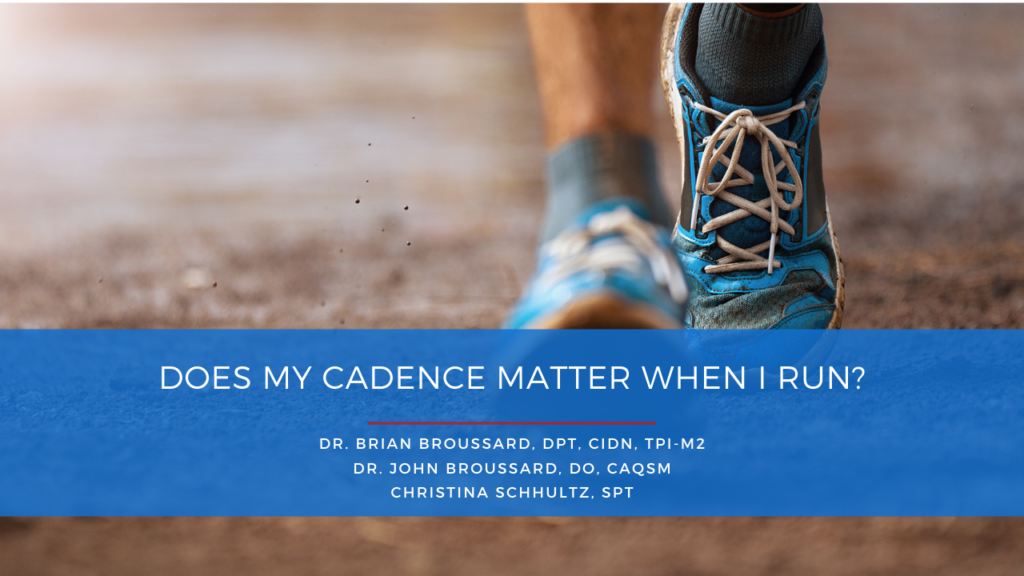What’s Your Rhythm?
Whether you’re an elite competitor, a weekend warrior, or a hobby jogger your body is affected by each step you take on your runs.
But you already know that because you feel it in your joints and muscles after a hard run and chances are you have experienced a running related injury. Have you ever wondered what you can do to decrease the stress on your body? Well let me introduce you to the new tool in your runner’s toolbox: cadence. What is cadence exactly? It’s way simpler than it sounds- It is the number of steps you take each minute.
In this blog were going to discuss why you might want to manipulate your cadence, how to do it, and what to expect from it.
If you are using a running watch, a lot of them will measure this for you. If not you can find out in 3 quick steps:
- Head out on a run and after a warmup, start a timer for 30s
- Count each time your right foot hits the pavement in this time
- Multiply this number by 2 to account for each foot and then by 2 again to convert to 1 minute
Why Does It Matter?
A low cadence has been associated with several common runner complaints. Low cadence in collegiate cross country runners has been found to be a risk factor for bone stress injury and shin pain while high cadence demonstrated a decreased risk of bone stress injury and shin pain (Kliethermes et al 2021). This is attributed to the high association of cadence and various ground reaction forces- this means when we take more steps per minute, we spend less time on each leg and at more optimal angles decreasing the force of the ground on our body. This study found that an increase of just 1 step per minute decreased risk of bone stress injury by 5%. The research on gait retraining and its effect on knee pain is mixed however several studies using gait retraining as a part of a multimodal approach show positive outcomes in reducing the runners’ pain. This is likely related to the decrease in forces at the hip and knee joints (Heiderscheit et al. 2011) combined with the strengthening or load management to optimize improvements.
What Do I Do With It?
If you are not currently dealing with an injury or have a history of frequent running injuries, you do nothing. You may have heard that 180 is the optimal cadence for efficiency and injury prevention but just because you do not hit that magic 180 number does not mean you are broken. Each person has slightly different biomechanics and the way we adapt to the load we put on our bodies is not identical. Bone length, age, height, and terrain are just a few examples of factors that may affect your cadence but can’t be changed. Runners with less experience tend to have lower cadence as do those running at slower paces. While an elite level athlete may have a cadence of 180 or higher, It is totally okay for you to have a cadence in the 160s if that is what is working for you.
If you are currently dealing with an injury or have a history of frequent injuries, this may be a sign that your biomechanics are less than ideal for your body and your current cadence may not be working for you. Increasing your cadence is a great troubleshooting tool you can easily try.
We are aiming for an increase of 5-10%. The evidence here is mixed In 2017 Gerrard and Bonnano found that there was a decrease in plantar forces with an increase of 10% but not at 5% whereas Kliethermes et al. found an increase of just 1 step per minute reduced bones stress injury risk. Heiderscheit et al. in 2011 found improved joint forces and angles with both 5 and 10% increases in cadence. What does this mean for you? It means we aim for an increase of 10% but if this is too difficult for you, you can try 5% first and may still see an effect depending on the person and the specific injury.
If you run with a phone this is easy! Simply download a metronome app to use on your run. Take your number you found on your run and multiply it by 1.1 (for 10% or 1.05 for 5%). Set your metronome to this goal cadence and take time each run practicing this new cadence. Its up to you how you implement it but one example would be running for intervals of 2 minutes with the metronome and then 5 minutes without to practice the new cadence.
Find the metronome annoying? That’s an easy fix- Google a song at whatever beats per minute your goal cadence is and keep your steps on beat.
Don’t worry, increasing your cadence does not mean you have to run faster. It simply means you are taking smaller steps and spending less time on the ground. You can expect for this to feel a little weird at first, but be patient and your body will adapt. It will begin to feel natural- maybe even better.
Will This Fix My Problem?
It depends. Running injuries can be complex and multifactorial. The source usually falls in a combination of 4 categories:
- Improper loading
- Biomechanical faults
- Musculoskeletal insufficiencies
- Stress (nutritional deficits, mental/emotional stress, and illness)
Cadence falls under the biomechanical category and is definitely something we should keep in our runner’s toolbox but there is likely other aspects that need to be addressed for optimal health and performance.
The takeaway here is that increasing cadence typically works best along with other treatments approaches and other treatment approaches work best with an increased cadence. Our job is helping you find that right combination specific to you and your body’s needs.
Dealing with a Running Injury? If you’re someone who is currently struggling with pain during or in between runs, we’d love to extend a special offer to you so you can finally take care of that pain once and for all!
50% OFF Our Complete Runners Fitness & Video Analysis: Simply click the link below to claim!
We’d like to thank Christina Schultz for leading this blog article as she was in the process of gaining her Doctorate of Physical Therapy!
Thank you for reading this installment to the Alliance Regen & Rehab Blog, we hope you enjoyed it and took some actionable information away form it!

